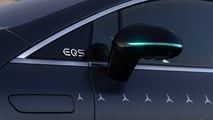Mercedes-Benz recently made headlines by securing approval for distinctive turquoise lighting elements on vehicles equipped with its Drive Pilot system in California and Nevada. This Mercedes Blue Light signifies the activation of the Level 3 automated driving system, marking a significant advancement in self-driving technology available to consumers. But what does this mercedes blue light mean for other drivers, and what is the significance of this innovative approach to vehicle communication?
Mercedes-Benz believes that this mercedes blue light will enhance public understanding and acceptance of automated driving technology. By clearly indicating when a vehicle is operating in autonomous mode, the turquoise lights allow other road users to anticipate the car’s behavior and adjust their driving accordingly. This visual cue fosters transparency and promotes safer interactions on the road. The distinctive mercedes blue light sets these vehicles apart from those with traditional driver-assistance systems.
Mercedes Blue Light: How Drive Pilot Works
Drive Pilot represents a major leap forward in driver-assistance technology. It’s the first commercially available hands-off, eyes-off system in the US, enabling drivers to cede control under specific conditions: approved highways, traffic below 40 mph, and clear weather. When activated, the mercedes blue light illuminates, signaling that the vehicle is in autonomous mode. The system utilizes an array of cameras and sensors to maintain lane position, adjust speed to match traffic flow, and monitor surrounding vehicles. While active, drivers can engage in secondary activities like reading or using the car’s infotainment system, but must remain alert and ready to resume control within 10 seconds if prompted.
Mercedes Blue Light vs. Level 2 Systems
Drive Pilot’s Level 3 classification distinguishes it from Level 2 systems like GM’s Super Cruise and Ford’s BlueCruise. While Level 2 systems offer hands-off capabilities, they require drivers to maintain visual attention on the road. Drive Pilot, indicated by the mercedes blue light, allows drivers to disengage visually under specific conditions, representing a significant step toward fully autonomous vehicles. This distinction underscores the innovative nature of Drive Pilot and its potential to revolutionize the driving experience. The mercedes blue light serves as a clear differentiator between these levels of autonomy.
Mercedes Blue Light: Paving the Way for the Future
The introduction of the mercedes blue light is not just about aesthetics; it addresses a critical challenge in the development of autonomous vehicles: communication. As self-driving technology advances, ensuring clear communication between autonomous vehicles and other road users becomes paramount. Mercedes-Benz’s innovative use of turquoise lighting sets a precedent for how vehicles can signal their intentions and operating modes, potentially influencing future industry standards.
Mercedes Blue Light: Beyond Visual Cues
While the mercedes blue light is a significant step, the future of autonomous vehicle communication likely extends beyond visual signals. Companies like Waymo are exploring alternative methods, such as displaying messages on external screens to communicate with pedestrians and other drivers. The ultimate goal is to create a comprehensive communication framework that ensures seamless and safe interactions between autonomous vehicles and all road users. The mercedes blue light is a pioneering effort in this ongoing evolution.
The mercedes blue light signifies more than just the activation of Drive Pilot; it represents a commitment to safety, transparency, and innovation in the rapidly evolving field of automated driving. As this technology continues to mature, the mercedes blue light may become a common sight on roads worldwide, heralding a new era of driving where humans and machines share the road in a more informed and collaborative way. The mercedes blue light is a beacon of the future of transportation.

